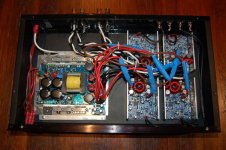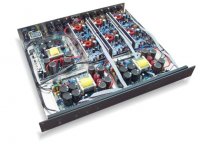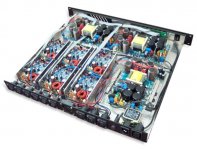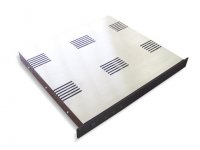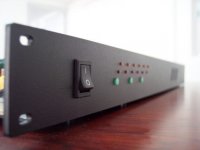Hi Pierre,
Yes, the best move was putting the - wire from the speaker output to the gnd pin on the amps pcb. BUT you have to twist the wires otherwise it is still not 100%. The problem is the EMI which is induced in the speaker lines and causes this crosstalk. The UCD's have very clean power lines so there are less problems with the wiring layout.
The total crosstalk is some 90Db@15Khz(still a bit dependant of wire routing).
About connecting the input grounds(on the RCA's) at the rear end of the housing, I use 2 100nf caps. to ground, 1 on each RCA ground to chassis.
My input wire has the same wiring connection as on the UCD inputs so on the connector at the amps PCB I connect a 10 ohm resistor in series with the ground and connect the - input directly to the wire ground. I use starpoint grounding at the PSU and this is the only real groundpoint. I know a lot of people disagree but this still is the best option for me with a single transformer powered double psu.
Yes, the best move was putting the - wire from the speaker output to the gnd pin on the amps pcb. BUT you have to twist the wires otherwise it is still not 100%. The problem is the EMI which is induced in the speaker lines and causes this crosstalk. The UCD's have very clean power lines so there are less problems with the wiring layout.
The total crosstalk is some 90Db@15Khz(still a bit dependant of wire routing).
About connecting the input grounds(on the RCA's) at the rear end of the housing, I use 2 100nf caps. to ground, 1 on each RCA ground to chassis.
My input wire has the same wiring connection as on the UCD inputs so on the connector at the amps PCB I connect a 10 ohm resistor in series with the ground and connect the - input directly to the wire ground. I use starpoint grounding at the PSU and this is the only real groundpoint. I know a lot of people disagree but this still is the best option for me with a single transformer powered double psu.
Bgt,
Let's see if I have understood ok:
You route only 2 wires from the amp to the RCA's, signal and GND? And you shortcircuit inverting input and GND _at the amplifier_. Then you run the GND to the RCA with 10 ohm in series?
If so, why did you chose that way instead of routing the three wires and shorting inv.input and GND AT the connector? (that supposedly helps removing the common mode noise pickup along the cable)
And at the RCAs, you put a 100nF cap from GND to chassis, one at each RCA, or do you do something more?
BTW: Have you measured crosstalk at other frequencies? Is that (15KHz) the worst case?
Thanks for sharing with us your fine-tunes!
Let's see if I have understood ok:
You route only 2 wires from the amp to the RCA's, signal and GND? And you shortcircuit inverting input and GND _at the amplifier_. Then you run the GND to the RCA with 10 ohm in series?
If so, why did you chose that way instead of routing the three wires and shorting inv.input and GND AT the connector? (that supposedly helps removing the common mode noise pickup along the cable)
And at the RCAs, you put a 100nF cap from GND to chassis, one at each RCA, or do you do something more?
BTW: Have you measured crosstalk at other frequencies? Is that (15KHz) the worst case?
Thanks for sharing with us your fine-tunes!
Pierre said:Bgt,
You route only 2 wires from the amp to the RCA's, signal and GND? And you shortcircuit inverting input and GND _at the amplifier_. Then you run the GND to the RCA with 10 ohm in series?
If so, why did you chose that way instead of routing the three wires and shorting inv.input and GND AT the connector? (that supposedly helps removing the common mode noise pickup along the cable)
And at the RCAs, you put a 100nF cap from GND to chassis, one at each RCA, or do you do something more?
BTW: Have you measured crosstalk at other frequencies? Is that (15KHz) the worst case?
Pierre, you're right about the way I did the input wire.
I've found out with the UCD's that if you ground the - at the RCA you have much more EMI pickup on the - lead/input. Connecting the - to ground at the amps input connector is much cleaner. You than dispose of the - input at the beginning of the amp.
Don't forget, this is the case in my setup where I use a star ground system at the PSU's 0V.
the 100nf's are connected as you described correctly.
the 15Khz measurement is just an average value.
At lower frequencies there is no crosstalk, well not measurable(is in the noise level) and at 20Khz it is a bit worse.
Don't forget that I always want the cleanest, least crosstalk signal and when touching/moving the cable tree in the housing my signal stays clean/undisturbed. If thats the case than I know I have a reasonable stable system and 1 that is not too sensitive to oscillate/disturbance at a possibly changing EMI field inside the housing.
After all is stable I start listening to the system.
PS it almost has no background hiss, it is a very quiet amp. Quieter than the Tripaths.
Just did an A-B switching test, the UCD's are dead quiet, just no hiss at all. My head was with my ear on the tweeter.
redone amp.
An externally hosted image should be here but it was not working when we last tested it.
4 channel coldamp
I have just finished building a new 4 channel Coldamp amp with the SPS80.
I am biamplifying my Energy Audissey 5+2 speakers. The Coldamp system replaces a 20 year old Yamaha M70 200wpc power amp.
I have incorporated as many of the suggestions on the application notes as I felt possible and have also included the Coldamp supplied filter chokes on all the + and - power lines to the modules(which havent been on any of the photos Ive seen to date).
Initial impressions:
absolutely silent. There is only a very faint crackle 2seconds after switching on.(almost inaudible)
There is no hint of whistles etc. I am not using the clock synchronisation capability.
Sound quality is absolutely amazing - powerful, dynamic and really clear. There is such a huge difference between this and the old amp. Theres certainly nothing I can comment on about anything lacking. It is just so good.
The amp actually gets quite warm (hot?). I left it turned on for a few hours with no signal and it was hot under the modules where attached to the steel chassis. Although cabinet has vents on top it hs no vents at bottom to allow air to be drawn in. Ill adjust this during next mods. SMPS side stays cool.
Photo of the wiring posted below. Unfortunately I tried to do everything I read - use as heavy wire as possible, twist all leads together, attach the chokes in series on each power lead close to the modules. These are incompatible with neat wiring though it could be better. Any advice on the criticality of all of these would be appreciated. The wiring is oversized x 2(10A). How critical is all of the twisting? How critical are the chokes. They are rated at 7A and have wire hair thin. I had to strap them to some insulation and encase in heat shrink to stop them being bent. Since theres no noise and no whistles it certainly works but not too professional looking at this iteration. (It is however my first electronics project)
Good support from Coldamp. There are some clarifications needed in the manual that were resolved quickly. would appreciate feedback from others on the above issues.
Cheers,
Derick
I have just finished building a new 4 channel Coldamp amp with the SPS80.
I am biamplifying my Energy Audissey 5+2 speakers. The Coldamp system replaces a 20 year old Yamaha M70 200wpc power amp.
I have incorporated as many of the suggestions on the application notes as I felt possible and have also included the Coldamp supplied filter chokes on all the + and - power lines to the modules(which havent been on any of the photos Ive seen to date).
Initial impressions:
absolutely silent. There is only a very faint crackle 2seconds after switching on.(almost inaudible)
There is no hint of whistles etc. I am not using the clock synchronisation capability.
Sound quality is absolutely amazing - powerful, dynamic and really clear. There is such a huge difference between this and the old amp. Theres certainly nothing I can comment on about anything lacking. It is just so good.
The amp actually gets quite warm (hot?). I left it turned on for a few hours with no signal and it was hot under the modules where attached to the steel chassis. Although cabinet has vents on top it hs no vents at bottom to allow air to be drawn in. Ill adjust this during next mods. SMPS side stays cool.
Photo of the wiring posted below. Unfortunately I tried to do everything I read - use as heavy wire as possible, twist all leads together, attach the chokes in series on each power lead close to the modules. These are incompatible with neat wiring though it could be better. Any advice on the criticality of all of these would be appreciated. The wiring is oversized x 2(10A). How critical is all of the twisting? How critical are the chokes. They are rated at 7A and have wire hair thin. I had to strap them to some insulation and encase in heat shrink to stop them being bent. Since theres no noise and no whistles it certainly works but not too professional looking at this iteration. (It is however my first electronics project)
Good support from Coldamp. There are some clarifications needed in the manual that were resolved quickly. would appreciate feedback from others on the above issues.
Cheers,
Derick
Attachments
Hi Derick,
Your amp. looks nice. My amps. are also not the finest looking wire wise. Thick wires are difficult for the looks. Anyway........its the sound and soundstage that matters. I dont use the inductors yet as they have no influence in my setup. With a SMPS it will be more usefull. I measured my amp. with a scope and it is absolutely an awsome amp. Crosstalk at 15khz is <100Db which is OK. No hiss,humm,clicks,rattles,startup/shut down bumps. Just dead,dead silent. Twisting speaker and psu wires is always OK. My amps don't use the sync. option also.
There is not 1 whistle and EMI is very low. It is situated 30cm from my FM tuner. No problem. I do use an inrush current limiter for the toroid and a speaker prot. unit. Wiring is done as follows:
http://www.grotel.nl/photo/wiring scheme class d stereo.jpg
Bert
Your amp. looks nice. My amps. are also not the finest looking wire wise. Thick wires are difficult for the looks. Anyway........its the sound and soundstage that matters. I dont use the inductors yet as they have no influence in my setup. With a SMPS it will be more usefull. I measured my amp. with a scope and it is absolutely an awsome amp. Crosstalk at 15khz is <100Db which is OK. No hiss,humm,clicks,rattles,startup/shut down bumps. Just dead,dead silent. Twisting speaker and psu wires is always OK. My amps don't use the sync. option also.
There is not 1 whistle and EMI is very low. It is situated 30cm from my FM tuner. No problem. I do use an inrush current limiter for the toroid and a speaker prot. unit. Wiring is done as follows:
http://www.grotel.nl/photo/wiring scheme class d stereo.jpg
Bert
re changes with coldamp
With the new amp I tried it initially in 2 channel (ie just swapped it in) then removed the jumbers on the speakers between the LF and HF side and ran 4 channels. Thus the answer is no it is not active. Subwoofer is crossed over before the poweramp though.
The simple 2 channel arrangement was also a significant improvement though I did not get the chance to sit down and listen to enough tracks to really give a valid judgement or comparison between 2 channel and 4 channel. Ill do this on the weekend as its easy to switch from 4 to 2 channel now.
Derick
With the new amp I tried it initially in 2 channel (ie just swapped it in) then removed the jumbers on the speakers between the LF and HF side and ran 4 channels. Thus the answer is no it is not active. Subwoofer is crossed over before the poweramp though.
The simple 2 channel arrangement was also a significant improvement though I did not get the chance to sit down and listen to enough tracks to really give a valid judgement or comparison between 2 channel and 4 channel. Ill do this on the weekend as its easy to switch from 4 to 2 channel now.
Derick
Hello, Derick, Bert.
Nice to hear your impressions about our modules. In fact, we are getting a lot of interest in the supplies but I must admit that we are much more proud of our amplifiers, a product we have invested a lot of development and fine-tuning time into
The heat dissipation is normal: the modules dissipate only 10W aprox at +/-60V, very similar to other modules out there with similar power capability. So in a 4 ch system you have an idle consumption of around 40W, enough to make the chassis hot.
This dissipation can be reduced by feeding the driver stage with a separate 12V suppy (referred to -VSS!!!, so the SPS80 aux +12V supply can be used for this as long as aux GND is NOT connected to power GND but to -VSS) and/or feeding the modulator with +/-12V supplies (although this doesn't worth the pain in terms of dissipation reduction). See app.notes for more details about this.
Please make sure that the mounting holes of the modules (and SPS80) are scrap free so the thermal contact is optimum. Don't forget to add a _SMALL_ layer of themal compound (I must insist: small).
Nice chassis, by the way!
Have a look at this 6ch 1U rack we have just custom-made for a client (yes, we can also design custom cases as we have laser cutting capabilities):
Nice to hear your impressions about our modules. In fact, we are getting a lot of interest in the supplies but I must admit that we are much more proud of our amplifiers, a product we have invested a lot of development and fine-tuning time into
The heat dissipation is normal: the modules dissipate only 10W aprox at +/-60V, very similar to other modules out there with similar power capability. So in a 4 ch system you have an idle consumption of around 40W, enough to make the chassis hot.
This dissipation can be reduced by feeding the driver stage with a separate 12V suppy (referred to -VSS!!!, so the SPS80 aux +12V supply can be used for this as long as aux GND is NOT connected to power GND but to -VSS) and/or feeding the modulator with +/-12V supplies (although this doesn't worth the pain in terms of dissipation reduction). See app.notes for more details about this.
Please make sure that the mounting holes of the modules (and SPS80) are scrap free so the thermal contact is optimum. Don't forget to add a _SMALL_ layer of themal compound (I must insist: small).
Nice chassis, by the way!
Have a look at this 6ch 1U rack we have just custom-made for a client (yes, we can also design custom cases as we have laser cutting capabilities):
Attachments
Expensive?
Have you had a look at our pricelist? The modules have a price very similar or cheaper than our competition while offering more features. The supply cost much less than a comparable size toroidal transformer + caps, diodes, etc. with much higher performance and lower price...
Have you had a look at our pricelist? The modules have a price very similar or cheaper than our competition while offering more features. The supply cost much less than a comparable size toroidal transformer + caps, diodes, etc. with much higher performance and lower price...
- Status
- This old topic is closed. If you want to reopen this topic, contact a moderator using the "Report Post" button.
- Home
- Amplifiers
- Class D
- Coldamp
